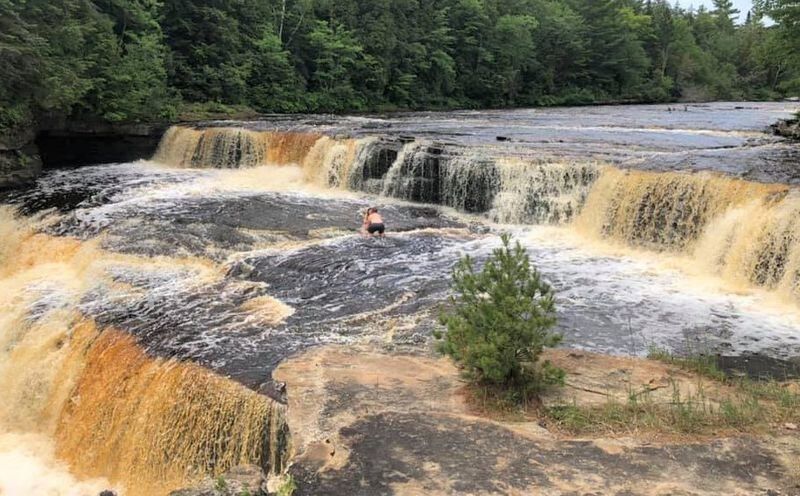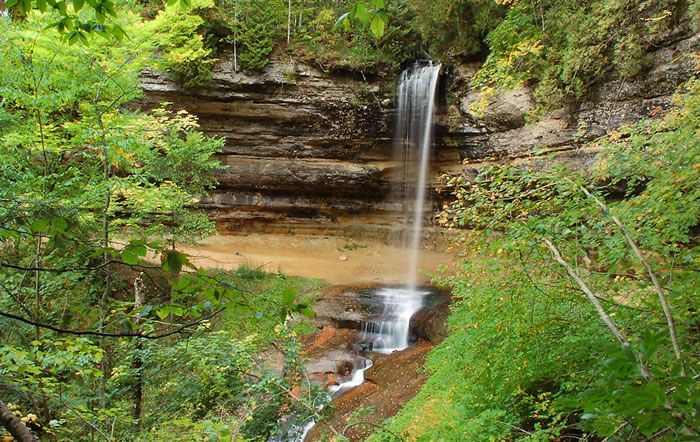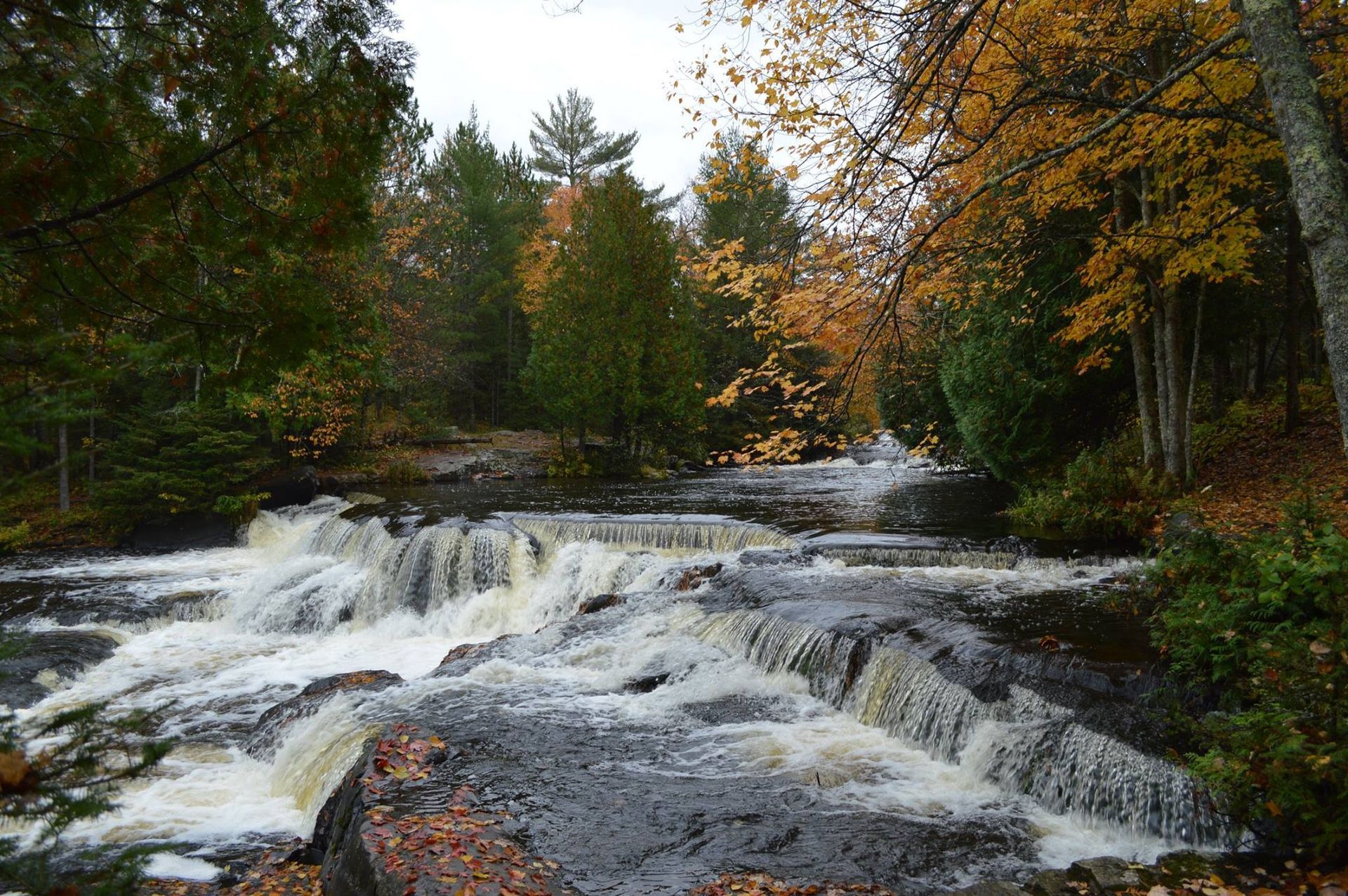Michigan's
Upper Peninsula Waterfalls
Exploring the Upper Peninsula of Michigan unveils a captivating tapestry of natural wonders, and among the most enchanting features are the numerous waterfalls that adorn the landscape. From the thunderous cascades of Tahquamenon Falls to the serene beauty of Munising Falls and the picturesque allure of Bond Falls, each waterfall in the Upper Peninsula carries its unique charm, contributing to the region's reputation as a haven for waterfall enthusiasts. Let's embark on a comprehensive journey, discovering the awe-inspiring beauty, geological significance, and immersive experiences offered by these remarkable Upper Peninsula waterfalls.
Tahquamenon Falls

Tahquamenon Falls, located in Tahquamenon Falls State Park near Paradise, Michigan, stands as one of the most iconic and voluminous waterfalls in the Upper Peninsula. The falls are renowned for their distinctive rust-colored water, a result of tannins leached from the cedar swamps that feed the Tahquamenon River. The park encompasses both the Upper and Lower Falls, each offering a unique perspective on the power and beauty of nature.
This post may contain affiliate links which means we may receive a commission from purchases made through links. Learn more on our affiliate disclosure page
Upper Falls:
The Upper Falls is the most iconic feature of the park and a showstopper by any measure. With a 50-foot drop and a width of more than 200 feet, it releases tens of thousands of gallons of water per second during peak flow periods in the spring. This impressive flow rate, coupled with the reddish hue, creates a striking image of raw power and natural beauty. Surrounding this dramatic waterfall is a network of viewing platforms strategically positioned along the riverbanks. These platforms provide spectacular vantage points, allowing visitors to witness the sheer energy of the falls and the river's relentless push as it descends over ancient sandstone cliffs. The thunderous sound of the cascading water resonates across the park, immersing visitors in an unforgettable sensory experience.
Multiple trails, including boardwalks and well-maintained pathways, allow for exploration around the falls. The most popular path to the Upper Falls offers a short yet scenic walk through a forested area rich with native flora and wildlife, enhancing the experience with a sense of immersion in Michigan’s wilderness. For those up for a challenge, the park offers a 4-mile hiking trail that connects the Upper and Lower Falls, winding through lush landscapes that offer glimpses of the river and the serene, dense forest.

Lower Falls
In contrast to the power of the Upper Falls, the Lower Falls present a more tranquil scene. Located four miles downstream, the Lower Falls consist of a series of five smaller cascades flowing around an island. These falls are smaller in height and width, yet they have their own serene charm that draws visitors who seek a peaceful connection with nature. Unlike the Upper Falls, the Lower Falls are ideal for closer exploration.
One of the standout activities here is renting a rowboat to reach the small island in the middle of the river, where you can view the falls up close. This experience allows visitors to feel surrounded by the calm, soothing waters and lush greenery that line the riverbanks. For those who prefer to stay on land, a walking trail loops around the falls, providing excellent views of the cascades and numerous places to sit and enjoy the sound of rushing water. Picnic areas close to the Lower Falls offer an inviting space for families and groups to enjoy a meal while taking in the natural beauty.
The Lower Falls can be particularly appealing for those who wish to wade in shallow water near the banks, as it is generally safer and more accessible than the Upper Falls area. During warmer months, many visitors find the cool, shallow water around the Lower Falls refreshing, and the area provides ample space for families to spread out and enjoy a relaxing afternoon surrounded by nature.
Accessibility and Visitor Amenities
Tahquamenon Falls State Park ensures accessibility for visitors of all abilities. Paved pathways, boardwalks, and wheelchair-accessible viewing platforms allow visitors to reach both falls without difficulty. The park also offers several amenities to enhance the visitor experience, including restrooms, picnic areas, and a gift shop with locally crafted items and souvenirs that capture the spirit of the falls. For those planning to stay longer, the park has camping facilities that offer a true Upper Peninsula outdoor experience, allowing visitors to immerse themselves in the landscape and sounds of the falls throughout the day and night.
Seasonal Beauty and Year-Round Appeal
Tahquamenon Falls is breathtaking year-round, with each season providing a distinct charm. In the spring, the falls are at their most powerful as snowmelt swells the river. Summer brings lush greenery, cool river breezes, and vibrant wildflowers. Autumn transforms the surrounding forest with fiery reds and oranges, creating a stunning contrast with the tannin-tinted waters. Winter, though quieter, offers an equally magical experience when the falls freeze into intricate icicles and the entire park becomes a snowy wonderland, with cross-country skiing and snowshoeing trails adding to the appeal.
Whether you're seeking the awe of powerful waterfalls, the tranquility of a river island, or the beauty of Michigan’s wilderness, Tahquamenon Falls State Park offers a journey into nature that is as inspiring as it is unforgettable.
Munising Falls
Munising Falls, tucked into the heart of Michigan’s Upper Peninsula within the Pictured Rocks National Lakeshore, is one of the most scenic and accessible waterfalls in the region. Known for its gentle cascade and the breathtaking sandstone cliffs that surround it, this waterfall offers a peaceful escape, whether you're a first-time visitor or a seasoned nature enthusiast. In this guide, you’ll find everything you need to make the most of your visit to Munising Falls, from the geology and history of the falls to trail information, tips for photographers, and seasonal highlights.
Introduction and Geology
Standing at about 50 feet tall, Munising Falls is a tranquil, ribbon-like cascade that plunges over a sandstone cliff into a small, shallow pool below. The cliff's rich red and orange hues are a result of the region’s unique geological history, dating back over 500 million years. This sandstone was formed from ancient, compressed sand dunes, and over time, it has been slowly eroded by the forces of wind, water, and freezing temperatures, creating a striking natural amphitheater around the falls. This type of rock, called the Munising Formation, is part of the same sandstone bed that stretches across Pictured Rocks National Lakeshore, giving it a distinct character and visual appeal.
The Munising Falls themselves are fed by Munising Creek, which meanders through a lush forest of cedar, hemlock, and sugar maple trees. These trees and other vegetation thrive in the shaded, moist environment around the falls, creating an enchanting green canopy in the warmer months and vibrant autumn hues in the fall.
Historical Significance
The Native American Ojibwa people lived in this region for thousands of years before European settlers arrived, and the waters and forests around Munising Falls were integral to their lifestyle and spiritual practices. The falls are part of a larger watershed area that was used for fishing, hunting, and gathering, with trails leading from the forest down to Lake Superior. When European explorers arrived, Munising and its surrounding areas became key points for logging and later tourism, as visitors began to realize the beauty of the region. In 1966, Pictured Rocks National Lakeshore was established as the first national lakeshore in the United States, encompassing Munising Falls as part of its protected landscape.
Planning Your Visit to Munising Falls
Munising Falls is easily accessible from downtown Munising, Michigan, and is a popular destination for locals and tourists alike. Here’s how to make the most of your visit:
Location and Directions
Munising Falls is located just a few miles east of downtown Munising. From Munising, take H-58 east, then turn north onto Washington Street. Look for signs pointing to Munising Falls on your left. The falls are located within a well-marked area with a dedicated parking lot, making it easy to locate.
Parking and Facilities
The Munising Falls parking area is equipped with picnic tables, restrooms, and a visitor center. Parking is free, and the lot is conveniently located near the trailhead, allowing easy access for visitors of all ages and abilities.
The Munising Falls Visitor Center offers maps, information on local trails, geology, and wildlife, and exhibits about the history of the Pictured Rocks National Lakeshore. Rangers and staff are available to answer questions, provide trail conditions, and suggest other nearby sites to explore.

Hiking to the Falls
One of the best aspects of Munising Falls is its accessibility. The waterfall is located only a short, 0.4-mile walk from the parking area along a flat, well-maintained trail that follows Munising Creek. This trail is rated as easy, making it perfect for families with young children, elderly visitors, or anyone looking for a short but scenic walk.
The path is framed by lush, verdant vegetation, and the creek adds a serene soundtrack as you approach the falls. Along the way, you'll pass interpretive signs that provide information about the local ecosystem, geology, and the history of the area. Benches along the path offer resting spots to enjoy the sights and sounds of nature.
Tips for Visiting Munising Falls
- Best Time to Visit: While Munising Falls is accessible year-round, the best times to visit are spring and fall. Spring offers high water flow, and fall provides beautiful foliage. Winter is also a special experience for those prepared for cold weather.
- What to Bring: Comfortable walking shoes, a camera, and water are essentials. In cooler months, dress in layers. In summer, consider insect repellent as mosquitos can be active near the creek.
- Respect Nature: Stay on designated trails and viewing platforms to protect the vegetation and prevent erosion. Do not climb on rocks near the falls, as they can be slippery and dangerous.
- Additional Attractions: Munising Falls is close to other waterfalls in the area, such as Wagner Falls and Miners Falls. Consider visiting these sites as part of a waterfall tour of the Pictured Rocks National Lakeshore.
Bond Falls
Tucked away in Michigan’s Upper Peninsula near the town of Paulding, Bond Falls is a hidden gem renowned for its breathtaking scenery and accessibility. As part of the Ontonagon River, the falls cascade down a series of rocky steps, creating a powerful yet serene scene that draws visitors year-round. The park surrounding Bond Falls is well-maintained, featuring paved paths, boardwalks, and multiple viewing platforms that allow for close-up views and different perspectives of the falls.
The falls’ unique tiered structure and the lush forest backdrop make it a favorite spot for photographers and nature lovers alike. With ample picnic areas, scenic walking paths, and benches along the way, Bond Falls offers a relaxing experience for families, hikers, and anyone looking to take in the beauty of Michigan’s landscapes. Its easily accessible location and picturesque setting make Bond Falls a must-see stop for those exploring the natural wonders of the Upper Peninsula. Whether you’re staying nearby or making a day trip, this charming waterfall provides a perfect mix of natural beauty, tranquility, and accessibility for all ages.
Multiple Cascades:
What distinguishes Bond Falls is its tiered structure, with a series of cascades descending over a gradual slope. This tiered formation allows visitors to witness the falls from various viewpoints, appreciating the intricacies of the water as it gracefully descends over the rocks. Bond Falls boasts a total drop of approximately 50 feet, creating a symphony of flowing water.
Accessibility and Amenities:
Bond Falls caters to visitors of all ages and abilities. A wheelchair-accessible boardwalk leads to the main viewing area, ensuring that everyone can enjoy the spectacle. Picnic areas and benches along the riverbanks provide opportunities for visitors to relax and soak in the peaceful ambiance. Interpretive signs offer insights into the geological and ecological aspects of Bond Falls.
Photographic Opportunities:
Photographers flock to Bond Falls to capture its serene beauty in different seasons. The lush greenery surrounding the falls transforms into a vibrant canvas during the fall foliage season, adding warm hues to the landscape. Winter, with its frozen cascades and snow-covered surroundings, provides a striking contrast, making Bond Falls a year-round destination for photography enthusiasts.

Nature Trails:
Exploring the waterfalls of the Upper Peninsula often involves traversing scenic nature trails that wind through dense forests and along riverbanks. These trails not only lead to the waterfalls but also offer glimpses of the diverse ecosystems that thrive in the region. Birdwatchers can spot various avian species, and nature enthusiasts can appreciate the vibrant flora that blankets the landscape.
Wildlife Encounters:
The natural habitats surrounding the waterfalls provide opportunities for wildlife encounters. Birdwatchers may spot eagles, hawks, and other bird species soaring above the cliffs and riverbanks. Deer, foxes, and other woodland creatures inhabit the lush forests, adding to the overall immersive experience of being in nature.
Seasonal Changes and Phenomena:
Each season brings a unique charm to the waterfalls of the Upper Peninsula. Spring sees the landscape awash in vibrant greens, with the waterfalls flowing robustly from the melting snow. Summer invites visitors to bask in the warmth and explore the trails under a canopy of leaves. Fall transforms the surroundings into a tapestry of reds, yellows, and oranges, creating a picturesque backdrop for the cascading waters. Winter, with its frozen waterfalls and snowy landscapes, provides a serene and tranquil ambiance.
Conservation and Stewardship:
Preserving Natural Beauty:
The popularity of the waterfalls in the Upper Peninsula underscores the importance of conservation and stewardship. Parks and natural reserves implement measures to protect the ecosystems surrounding the waterfalls, ensuring that the natural beauty remains unspoiled for future generations. Visitor education programs emphasize responsible tourism practices to minimize the impact on delicate environments.
Collaborative Conservation Efforts:
Local communities, environmental organizations, and governmental agencies collaborate to implement conservation initiatives. These efforts include habitat restoration, water quality monitoring, and initiatives to protect wildlife. Collaborative conservation ensures that the ecosystems supporting the waterfalls remain healthy and resilient in the face of environmental challenges.
Visitor Experience:
Educational Interpretation:
Parks and visitor centers near the waterfalls provide educational interpretation through exhibits, guided tours, and ranger-led programs. Learning about the geological forces that shape the waterfalls, the cultural significance they hold, and the ecosystems they support enriches the visitor experience. Interpretation also fosters a sense of responsibility and stewardship among those who come to admire the falls.
Recreational Opportunities:
Waterfalls in the Upper Peninsula offer a myriad of recreational opportunities. Beyond hiking and sightseeing, visitors can engage in activities such as photography, birdwatching, and even winter sports like snowshoeing and cross-country skiing. Parks often provide amenities such as picnic areas, campgrounds, and facilities for visitors to make the most of their time in these natural havens.
Connecting with Local Communities:
Exploring the waterfalls in the Upper Peninsula provides an opportunity to connect with local communities. Small towns and villages near these natural attractions often welcome visitors, offering a glimpse into the unique culture and history of the region. Local businesses, from quaint cafes to artisan shops, contribute to the overall experience of immersing oneself in the charm of the Upper Peninsula.